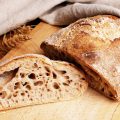Let’s chat about two bread favorites – sourdough and whole wheat. You’ve probably tasted them both, right? They’re pretty popular choices when it comes to bread. Ever wondered what sets them apart? They actually differ quite a bit in terms of taste, nutrition and much more. So, grab a slice (of either!) and let’s break down the delicious details of sourdough vs whole wheat.

Table of Contents
- Whole Wheat vs Sourdough
- Is Sourdough Bread Better than Wheat Bread?
- Sourdough vs Wheat: Taste Test
- Baking Process
- Nutritional Comparison
- Health Benefits
- Is Sourdough Healthier than Wheat Bread?
- Other Healthy Bread
- Which Bread is Better for Diabetics?
- Which Bread is Better for Weight Loss?
- Which Bread is Better for Cholesterol?
- Whole Wheat Bread Recipes
- Sourdough Bread Recipes
- Sourdough or Whole Wheat?
- FAQs
Whole Wheat vs Sourdough
Whole grain breads are often more nutritious than their white bread counterparts, because they contain all three parts of the grain: bran, endosperm, and germ. These parts contain various vitamins, minerals and fiber that help keep us healthy.
The problem with whole grains is that they can be hard to digest if you don’t consume them regularly or properly prepare them before consumption. Sourdough breads are easier to digest than regular breads because they contain probiotic bacteria, which helps improve our digestive health by breaking down food into smaller particles so we can absorb its nutrients better.
Sourdough bread is made with sourdough starter, which is a combination of water and flour that has been fermented and allowed to grow bacteria and yeast. It’s not the same as the sour taste you might get from eating spoiled food. Sourdough starters are actually quite mild. The fermentation process breaks down complex carbohydrates in flour into simple sugars, making it easier for your body to digest.
By contrast, regular bread gets its flavour primarily from yeast; this means that when your body digests regular bread, your pancreas sends out insulin to break down those simple sugars into energy instead of storing them as fat cells.
Is Sourdough Bread Better than Wheat Bread?
Sourdough bread differs from wheat in two major ways: it contains less gluten, and it has more beneficial bacteria. While sourdough is certainly better for you than regular white bread, the main question is whether it is actually better than wheat.
A popular reason for eating sourdough is that it’s easier to digest than wheat bread. This is because sourdough contains probiotics, which are good for your gut health. The fermentation process makes the yeast and bacteria into lactobacilli, which helps break down the fiber in the bread, making it easier to digest.
On the other hand wheat bread comes with its own benefits, with a good fiber content and lower calorie count. Those who follow a strict diet may find themselves reaching for this bread a lot more than sourdough bread.
The main difference between these types of bread is their taste. Sourdough bread has an attractive tangy flavor, that pairs perfectly with almost anything, whereas whole wheat bread is pretty bland, with its simplicity not always making it the better bread to go for.
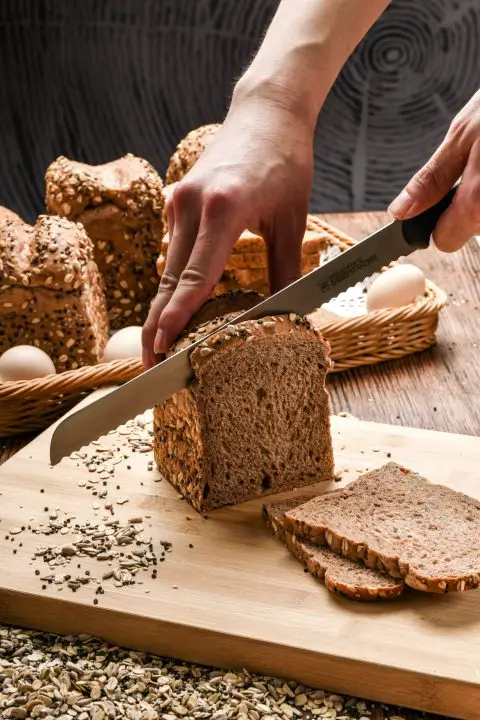
Sourdough vs Wheat: Taste Test
Sourdough bread is denser, chewy, and less sweet than fresh bread. It also has a slightly sour taste that can be pleasing to many people. Although it might not seem like it at first glance, sourdough is actually more nutritious than fresh bread because it contains less sugar and fat.
Sourdough can be made at home using a starter (a mixture of flour and water). The starter needs to be kept in the refrigerator between uses so that you have some on hand whenever you’re ready to make more sourdough.
Unlike fresh bread, the taste of sourdough continues to change and mature over time. The longer you allow it to age, the more complex its flavor will become, as it picks up other flavors from your kitchen. With some bakers waiting up to 3 days before baking their wonderfully fermented dough, producing unique and distinctive flavors that have many coming back for more!
Of course, whole wheat bread has a flavour all its own. It’s often described as having a nutty, tangy or earthy taste, but it can also have sour and bitter notes. In addition to these flavours, whole wheat bread can be spicy or savoury – like some types of rye – rich and musty.
Baking Process
The primary difference between these baking processes lies in the fermentation.
Sourdough undergoes a lengthy fermentation, which breaks down complex carbohydrates and develops its characteristic flavor. Whole wheat bread, conversely, has a shorter fermentation and relies more on the natural flavors of the whole grain for its taste.
The Sourdough Method
Sourdough baking is a unique process that relies on wild yeast and bacteria for fermentation. It begins with a sourdough starter, which is a mixture of flour and water that has been allowed to ferment, cultivating wild yeast and beneficial bacteria.
To start the baking process, we mix the active starter with additional flour and water to create what’s known as the “levain.” This mixture ferments for several hours, developing the complex flavors characteristic of sourdough. After this initial fermentation, we combine the levain with the remaining ingredients to form the dough.
The next stage involves a long fermentation period, which can last up to 24 hours. During this time, the wild yeast breaks down the flour and creates the air pockets that give sourdough its distinctive texture. Periodically, we fold the dough to strengthen its structure.
Once fermentation is complete, we shape the dough into a loaf and allow it to proof one final time. The bread is then baked in a very hot oven, resulting in a crusty, flavorful loaf with a slightly tangy taste.
Whole Wheat Approach
Whole wheat bread making follows a more direct process. It starts with whole wheat flour, which includes all parts of the wheat kernel: the bran, germ, and endosperm. This composition gives whole wheat bread its nutty flavor and hearty texture.
The process begins by combining whole wheat flour with water, salt, and often a small amount of honey or molasses for sweetness. Unlike sourdough, whole wheat bread typically uses commercial yeast for leavening, which significantly reduces the fermentation time.
After mixing the ingredients, we knead the dough to develop the gluten structure. Whole wheat flour absorbs more water than white flour, often resulting in a stickier dough that requires more effort to knead. Once kneaded, the dough undergoes its first rise, usually lasting about one to two hours.
Following the initial rise, we shape the dough into a loaf and allow it to rise again before baking. The result is a dense, nutritious bread with a robust flavor profile.

Nutritional Comparison
Both types of bread have similarities, but there are some key differences to consider.
Sourdough bread has a slight advantage in terms of carbohydrate content due to its fermentation process. This process breaks down some of the complex carbohydrates, making them more digestible. Whole wheat bread, however, retains all of its natural fiber, providing a higher fiber content per serving.
In terms of protein content, sourdough and whole wheat bread are fairly similar. Both offer a moderate amount of protein, though neither should be considered a primary protein source in one’s diet.
Whole wheat bread is particularly rich in micronutrients. It contains significant amounts of B vitamins, iron, and magnesium. It’s also a good source of vitamin E and zinc, contributing to skin health and immune function respectively.
Sourdough bread, while not as nutrient-dense as whole wheat, has its own advantages. The fermentation process increases the bioavailability of minerals like iron and zinc. This means that although it may contain less of these nutrients overall, the body can more easily absorb and utilize what is present.
Sourdough bread offers some unique health benefits due to its fermentation process. The lactic acid produced during fermentation can lower the bread’s glycemic index, potentially leading to less dramatic fluctuations in blood sugar levels compared to other types of bread.
Whole wheat bread excels in fiber content, containing both soluble and insoluble fiber. This high fiber content is beneficial for digestive health and can contribute to feelings of fullness.
Both sourdough and whole wheat bread contain various phytochemicals, which are plant compounds that may have anti-inflammatory and antioxidant properties.
Health Benefits
Both sourdough and whole wheat bread offer significant benefits for digestive health, albeit in different ways.
Sourdough’s fermentation process introduces beneficial bacteria to the bread. These probiotics are valuable for gut health, aiding in the breakdown of nutrients and improving their absorption in the body.
Whole wheat bread, on the other hand, excels in fiber content. It’s rich in insoluble fiber, which is crucial for maintaining regular bowel movements and promoting overall digestive health. If you’re looking to improve your digestion, incorporating whole wheat bread into your diet can be particularly beneficial.
The glycemic index (GI) is an important factor to consider when choosing bread, especially if you’re concerned about blood sugar levels. Sourdough bread has a distinct advantage in this area. The fermentation process actually lowers its GI, resulting in a more stable blood sugar response after consumption.
While whole wheat bread doesn’t lower GI to the same extent as sourdough, it still performs well in this area. The high fiber content in whole wheat bread slows down digestion, leading to a more gradual release of sugars into the bloodstream. Both options are significantly better choices than refined white bread for managing blood sugar levels.
When it comes to cardiovascular health, both sourdough and whole wheat bread offer notable benefits. Whole wheat bread is particularly noteworthy for its nutrient profile that supports heart health. It’s an excellent source of B vitamins, including folate, which plays a crucial role in maintaining cardiovascular health.
Sourdough bread also contributes to heart health in its own unique way. The fermentation process creates compounds that may help lower cholesterol levels. This potential cholesterol-lowering effect adds to sourdough’s appeal as a heart-healthy option.
It’s important to note that while both types of bread offer health benefits, moderation is key. Overconsumption of any food, even healthy options, can lead to unwanted weight gain, which can negatively impact overall health.
Is Sourdough Healthier than Wheat Bread?
Sourdough bread is easier to digest compared to whole wheat bread, because it is made with a natural starter that breaks down the starches in flour and increases the presence of bacteria. This process helps you break down food faster so that you can absorb nutrients faster and have less indigestion issues.
On the other hand, whole wheat bread offers greater amounts of calcium, iron and vitamin B6, which are also incredibly beneficial to the body. Meanwhile, whole wheat bread doesn’t undergo the same fermentation process as sourdough and therefore isn’t as easy for your body to digest.

Other Healthy Bread
Bread can be very unhealthy. For those following a low carb, or keto diet where your daily carb intake is limited, enjoying a slice of bread, might not be a common occurrence.
With one slice of white bread containing 24 grams of carbs and a slice of whole wheat bread containing 23 grams of carbs, you might want to stick around to scope out the healthier alternatives for you to enjoy in abundance:
Sprouted Grain Bread
The health benefits of sprouted grain bread are numerous. The sprouting process breaks the grain down and makes it easier to digest, which can lead to improved nutrient absorption. In addition, sprouted grains are lower in calories and higher in fiber than regular grains.
This makes them ideal for weight loss or maintenance programs as well as for people with diabetes and other gastrointestinal disorders, who often find that a diet rich in fiber helps manage their symptoms.
Rye Bread
Rye bread is a type of bread made from rye flour. Rye flour has a higher percentage of fiber, protein and vitamins than other types of wheat flour.
Rye bread is a good source of calcium and vitamin D, which are important for the health of your bones. It’s also high in iron, magnesium, zinc and selenium which are minerals that help fight inflammation in the body.
(By the way, I have a rustic rye sourdough and a rye sourdough bread recipe!)
Whole-Wheat Pita Bread
Whole wheat pitas are made from whole grains, which are a good source of fiber protein, vitamins and minerals. This makes them a healthy choice for your diet.
Whole-wheat pitas contain about 2 grams of dietary fiber per serving. You need 25 to 30 grams of dietary fiber every day to help keep your digestive system healthy and regulate blood sugar levels.
A whole-wheat pita can also help you get 12% of the recommended daily amount of protein if you eat one as a meal or snack. Protein is an important macronutrient that helps build muscle mass and repair tissue damage
Sourdough Bread
Sourdough bread is made from a fermented dough. Rather than using a commercial yeast to make the dough rise, sourdough uses a starter which is a mixture of flour and water that’s been left out for several days to ferment. This process results in bread that’s more nutritious and digestible than other types of bread, as well as more flavorful.
You can use any type of flour you desire to make the starter. Using whole wheat flour is also an option!
Bran Muffins
Bran muffins are a healthy alternative to white flour muffins. These muffins are high in fiber and protein, but they contain less sugar, fat, and calories than traditional muffins. Bran is the outer layer of grains such as wheat, oats or corn. It contains most of the grain’s vitamins and minerals including B vitamins, iron and zinc.
Which Bread is Better for Diabetics?
Sourdough and whole wheat each offer unique benefits.
Sourdough’s fermentation process often results in a lower glycemic index compared to other breads, potentially leading to a more gradual rise in blood sugar levels.
Whole wheat bread, with its high fiber content, can slow down sugar absorption, helping to regulate blood sugar and insulin levels.
Whole wheat bread provides a range of vitamins and minerals, including B vitamins, iron, and magnesium, which can support overall health and blood sugar regulation.
Sourdough, while less nutrient-dense, may improve insulin sensitivity due to the lactic acid produced during fermentation.
Both sourdough and whole wheat can be part of a diabetic-friendly diet. Sourdough may be preferable for its lower glycemic index, while whole wheat offers more nutrients. The best choice depends on individual health needs and blood sugar responses. Portion control remains important regardless of the type chosen.
Which Bread is Better for Weight Loss?
Whole wheat bread typically contains 80-100 calories per slice, while sourdough ranges from 80-150 calories, depending on the recipe. However, calorie content alone doesn’t tell the full story.
Whole wheat bread excels in fiber content, with up to 3 grams per slice. This high fiber content aids digestion and promotes feelings of fullness. Sourdough, while lower in fiber, offers improved nutrient bioavailability due to fermentation.
Sourdough bread often has a lower glycemic index than whole wheat, potentially helping to manage blood sugar levels and reduce hunger. Whole wheat’s higher fiber content also contributes to longer-lasting satiety.
Both whole wheat and sourdough can be part of a healthy weight loss diet. Whole wheat offers more fiber and consistent nutrients, while sourdough may provide better digestion and blood sugar control. The best choice depends on individual preferences and dietary needs.
Which Bread is Better for Cholesterol?
Whole wheat bread is rich in dietary fiber, which can help lower cholesterol levels. Fiber binds to cholesterol in the digestive tract, preventing its absorption into the bloodstream. This makes whole wheat bread particularly effective for managing LDL (bad) cholesterol.
Sourdough bread, while lower in fiber, offers unique cholesterol-lowering properties. The fermentation process creates compounds that may help reduce cholesterol levels. Additionally, the breakdown of phytates during fermentation can improve the absorption of cholesterol-lowering minerals.
Both whole wheat and sourdough bread may support HDL (good) cholesterol levels. Whole wheat’s fiber content and sourdough’s fermentation byproducts can contribute to this effect.
For cholesterol management, whole wheat bread is generally the better choice due to its higher fiber content. However, sourdough can still be a heart-healthy option. A whole wheat sourdough combines benefits from both types. Regardless of choice, moderation is key for maintaining healthy cholesterol levels.
Whole Wheat Bread Recipes
Whole wheat bread is made with whole wheat flour, which means it contains all of the components of the grain. This bread can be made with or without yeast, depending on your preference for texture or ease of preparation. It provides a distinctly nutty flavor that pairs well with many soups. It’s also an excellent source of fiber, with each slice containing about 3 grams.
Here’s some whole wheat recipes for you to try:
- Banana Bread
- Cranberry Nut Bread
- Pitta Bread
Banana Bread
This perfectly moist whole wheat banana bread, tastes just as good as normal banana bread. You can swap sugar for honey, and butter with unsweetened apple sauce, if you’re really pushing for a healthier breakfast!
You’ll need:
- 4 ripe bananas
- butter or unsweetened apple sauce
- 2 eggs
- Sugar or honey
- 2 tsp vanilla extract
- 1 1/2 cups whole wheat flour
- 3 tsp baking powder
- Salt
- Preheat the oven to 350 degrees.
- Lightly grease a loaf pan and set it aside.
- In a large bowl, combine bananas, butter, eggs, sugar and vanilla extract until smooth; add flour mixture and stir just until combined.
- Pour into prepared loaf pan and bake for 50-60 minutes until a toothpick inserted in center comes out clean or until top springs back when pressed lightly with your finger.
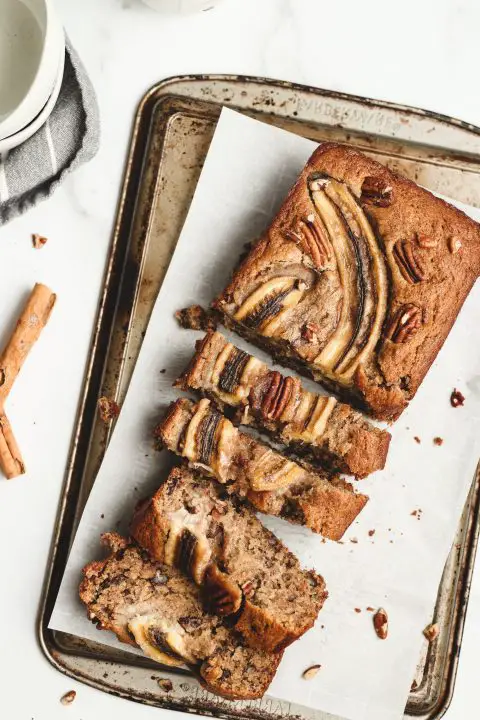
Cranberry Nut Bread
A scrumptious nutty bread, for you to add to your list of healthy bread recipes! Pair this cranberry whole wheat bread with a cup of hot chocolate, or simply devour it on its own! Check out this brilliant recipe.
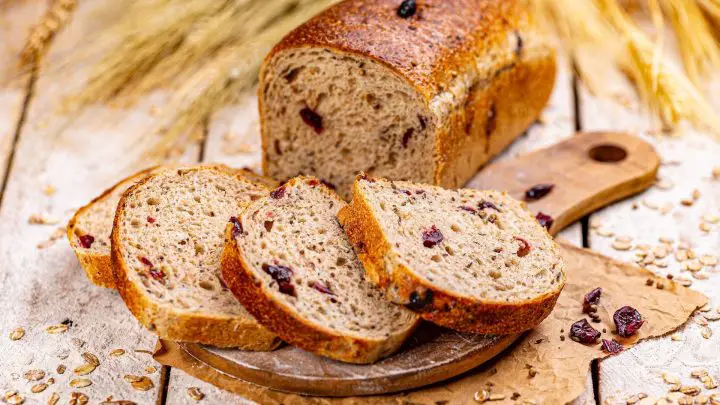
Pita Bread
Pita bread is most commonly used in middle eastern cuisine, but it can be found in many other cuisines as well. It can be used for sandwiches, dipping, dessert and an endless list of things! You can use it to make pizza or sausage, tacos or wraps!
Pita is great if you’re looking for a healthy alternative to white bread.

Sourdough Bread Recipes
Sourdough or Whole Wheat?
You may decide that sourdough bread is the better option when it comes to incorporating healthier bread in your diet. The fermentation process that sourdough undergoes makes it more easily digestible and lowers certain types of sugars. Not to mention its potent tangy flavors that are heavily enjoyed with soups and savories!
FAQs
Is Sourdough Bread Healthier than Whole Wheat Bread?
Sourdough is actually healthier than white or whole wheat bread, though its nutrients are comparable; the lower phytate levels makes it more digestible and nutritious.
What is the Healthiest Bread You Can Eat?
There are many types of healthy bread for you to choose from: Sprouted whole grain, sourdough, 100% whole wheat, oat bread, flax bread, and more.
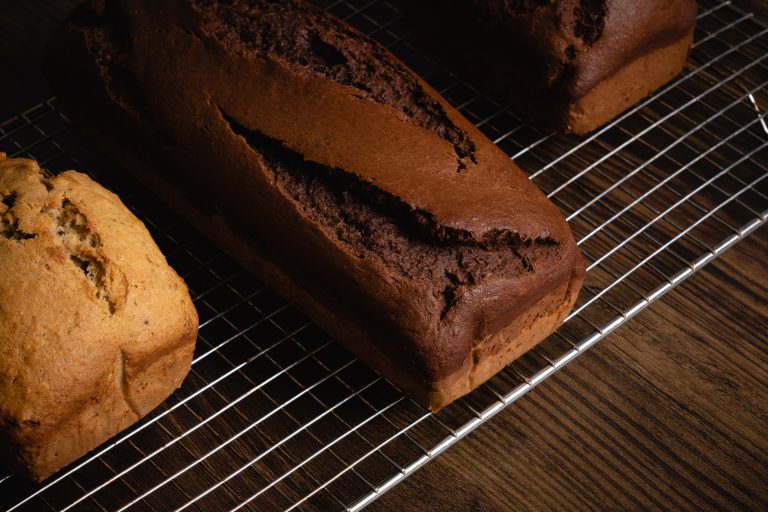
Banana Bread
This perfectly moist whole wheat banana bread, tastes just as good as normal banana bread. You can swap sugar for honey, and butter with unsweetened apple sauce, if you’re really pushing for a healthier breakfast!
- Total Time: 1 hour
- Yield: 1 loaf 1x
Ingredients
- 4 ripe bananas
- butter or unsweetened apple sauce
- 2 eggs
- Sugar or honey
- 2 tsp vanilla extract
- 1 1/2 cups whole wheat flour
- 3 tsp baking powder
- Salt
Instructions
- Preheat the oven to 350 degrees F.
- Lightly grease a loaf pan and set it aside.
- In a large bowl, combine bananas, butter, eggs, sugar and vanilla extract until smooth; add flour mixture and stir just until combined.
- Pour into prepared loaf pan and bake for 50-60 minutes until a toothpick inserted in center comes out clean or until top springs back when pressed lightly with your finger.
- Cook Time: 60 mins
- Category: bread





